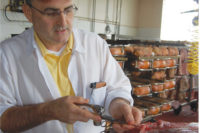On the Road Again
Several communities around the country have come up with a solution - if they can’t bring the animals to a slaughterhouse, they can bring a slaughterhouse to the animals. Mobile slaughter units, which are large trailers containing everything needed to harvest livestock and prepare the carcasses for further processing, are popping up in communities throughout the United States. There are more than a dozen such facilities in existence, processing everything from beef, pork and chicken to exotic deer, bison and reindeer. These trailers, under inspection by state or federal employees, are giving producers an opportunity to market their meat products in farmer’s markets and local retail and foodservice establishments.
Texas roots
The beginning of the mobile slaughter concept came from Mike Hughes, owner of Broken Arrow Ranch in Ingram, Texas. He got the concept for field harvesting of exotic deer approved in the early 1980s, and since then, Broken Arrow has specialized in the shooting, slaughter and processing of exotic deer and antelope throughout south Texas. The company also sells the meat to fine-dining restaurants throughout the country.
“We go out to different ranches, and we tow the mobile slaughter unit with us,” explains Glen Hollowell, operations manager. “We do the shooting of the deer in the field and bring it back to our unit, and we have a skinner and a state inspector who travels with us. They do all the skinning and evisceration inside the portable slaughter unit.” The clean carcasses are put inside the unit’s cooler and transported back to the company’s meat room, where the final processing is done.
Broken Arrow has two units, one of which is located in South Texas and the other that covers the Hill Country. The company processes axis, sika and fallow deer, blackbuck and nilgai antelope and wild boar. The units are about 34 feet long, and they were manufactured in Houston to fit the needs of the area. The South Texas unit harvests mostly nilgai, which are bigger animals, so the unit is a little larger. That unit doesn’t have a cooler, because the company uses a nearby refrigerated truck to store the carcasses. The South Texas unit has a cooler with a capacity of 40 carcasses.
Hollowell notes that there are very few slaughterhouses in the area. While there are some custom exempt places, they are unable to do what Broken Arrow does.
“You can shoot the animal and take the animal to [custom exempt facilities], and they give you the meat back, but they can’t sell it,” he points out. “That’s why we’re so valuable to our customers. We slaughter the animal, process the animal and do the final cuts in our meat room. No one else touches [the] product, and we do not sell to purveyors. It goes straight to the customer - field to plate, basically.” Furthermore, he adds, deer do not trap well, so bringing live animals to a slaughterhouse is extremely difficult.
While Broken Arrow is state inspected, the company’s game products are not considered amenable to USDA standards, so the company is able to ship its product across state lines. Hollowell says that the company sells product to all 50 states.
A similar unit to the Broken Arrow slaughter units is in use in upstate Washington, where a group of farmers on the Puget Sound islands and the nearby mainland have been utilizing a mobile slaughter unit since 2002. One of the farmers, Bruce Dunlop, has become an authority on the subject and has helped build several units for other communities. Dunlop, president of Lopez Island Farm and a member of the Island Grown Farmers Cooperative, says that their situation mirrors what is happening around the country.
“The market demand started to appear for more locally produced, organic, grass-fed meat,” he says. “There is no corresponding infrastructure left to do the processing under federal or state inspection, where it can be sold as individual cuts.” Without a slaughter/processing solution in sight, the co-op decided that a mobile unit would be a way to bring an inspected slaughter and processing program to the area without the cost and troubles of building a slaughter facility.
The trailer was built in Washington state and is approximately 32 feet long. Dunlop visited Broken Arrow Ranch, and came away with plenty of photographs and notes about putting together a proper unit. The hardest part was addressing the FSIS regulations and concerns, Dunlop says.
“There’s no difference in the regulations for it, but of course, there is a different way in complying with them than a fixed facility would do,” he says. Carcass chilling, offal disposal and holding the live animals all had to be addressed.
The slaughter unit is owned by the cooperative, which contains about 64 farms. Some of the farms use the unit every week or two weeks, while others may only need its services once a year.
The unit travels to one location on any given day, and the inspector assigned to the unit meets it at that location. Pigs, lambs, goats and cows are all slaughtered and processed by the unit, and the carcasses are transported to the cooperative’s processing facility for cutting and packaging. Offal is generally composted at the farm. The cooperative leased a building to do the further processing.
Each of the farmers in the co-op are responsible for the selling of their product. Farmers markets and small, independent grocery stores are a big draw, as are local restaurants looking for high-quality local meats.
“They’re prepared to pay for the quality of the product, but they’re a demanding customer, which I guess is good,” Dunlop says. “It forces you to live up to their standards.”
Dunlop has since become a consultant for other groups who are looking for a mobile slaughter unit of their own. He works with a trailer manufacturer that builds the unit and installs the necessary equipment. He estimates that he’s helped build about seven such trailers. Some of those are proper mobile slaughter units, while others, located in Maui and eastern Washington, are used more as modular processing facilities.
“There’s huge chunks of this country that don’t have small-scale slaughter plants at all,” Dunlop comments. “We have a lot of interest from farmers and farm groups who want to sell their product but have no experience with processing. That is the same situation we were in 10 years ago.” He points out that building a slaughter facility is a huge undertaking for one person, which is why the Island Grown Co-op did it as a group effort.
Non-profit processing
One of the trailers that Dunlop helped build was delivered to the Taos County, N.M., Economic Development Center, a non-profit organization. The TCEDC has, for the past 23 years, sought to support businesses and residents of a relatively isolated community. It has built a business park and runs the Taos Food Kitchen, a 5,000-square-foot commercial kitchen that supports local food businesses.
Pati Martinson, who along with Terrie Bad Hand serves as co-director, says that the community has a long tradition of sustainable agriculture and bartering that has allowed Taos to enjoy local food - a tradition that had become severely interrupted.
“All our [slaughter] facilities were closing, and people were becoming accustomed to buying their meat from the local grocery store, always with an awareness that it wasn’t the same as the locally raised, free-range beef, pork and lamb,” she says.
The TCEDC heard about the success of the Washington state program and talked with Dunlop about a mobile unit. It secured $200,000 from the state of New Mexico to build a “Mobile Matanza” (Spanish for “slaughter”) unit.
Martinson says the original plan was to run the Mobile Matanza under state inspection, but after the unit was built, New Mexico turned over all inspection duties to the FSIS. That caused a delay while the TCEDC could get a federal grant of inspection, but the unit held its grand opening in 2007. Since then, the organization has also opened a cut-and-wrap facility in its business park to process the meat. Martinson says the unit serves a 100-mile radius and processes beef, pork, lamb and bison.
“We never intended to be the only game in town, but sometimes it feels like we are,” she says.
There is a commercial aspect to it, as the TCEDC has helped local producers get their meat into local restaurants and small, independent grocery stores. However, Martinson notes the cultural importance of the Mobile Matanza.
“Our emphasis on doing this was to help people really hold on to their traditional lifestyles, to be able to keep their land, use their water and, more particularly, continue and pass on the sustainable tradition,” she says. Since the start of the program, more than 220,000 pounds of locally grown meat have been delivered to the community.
As a non-profit organization, the TCEDC has struggled with costs of running the unit and processing facility, including training and employing workers and maintaining and replacing equipment. The farmers do pay a fee for using the Mobile Matanza, and Martinson says the goal is to get the program to pay for itself and help other communities get their own units.
“Of course, [our hope is] to get the attention of a big foundation or somebody who felt that it would be worth investing for a few years in the organization that’s doing the research and development, especially in terms of helping with the employees,” she adds.
Looking for a reprint of this article?
From high-res PDFs to custom plaques, order your copy today!





